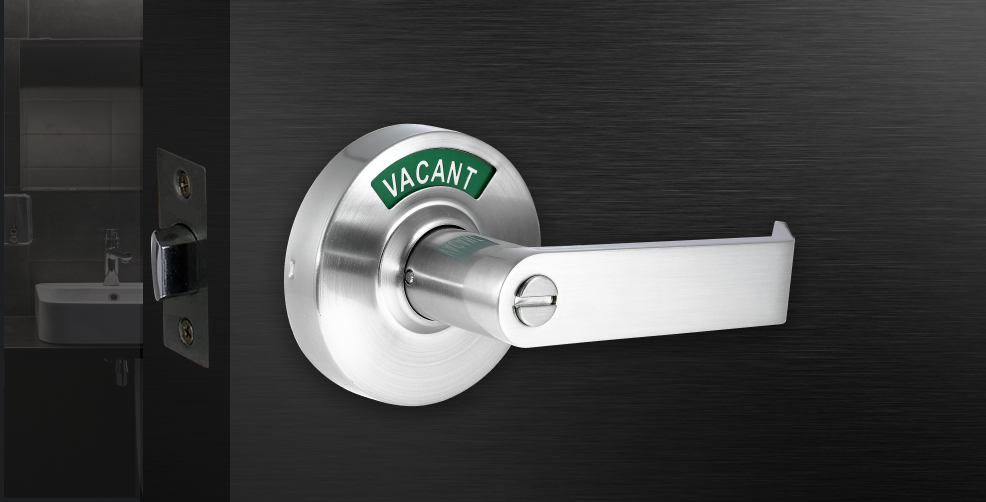Overview and General Requirements
Hospitals and other healthcare facilities have specific types of requirements for the various doors on their properties. Bathrooms are especially particular, and there are ADA requirements regarding door hardware and door opening applications that must be adhered to.
The Americans with Disabilities Act, or ADA, is a law that serves to protect and guarantee the equal rights of those with disabilities, to ensure they can access different public spaces with ease. All public spaces are required to meet ADA requirements, especially in regards to places of work. ADA regulations are second only to building codes for public buildings and spaces, ensuring the rights and accessibility of persons with disabilities are upheld. While ADA standards have been required for decades now, there are many public spaces that fail to meet all of these regulations to ensure safety and security for all individuals in public restrooms.
What is an ADA-compliant bathroom?
An ADA-compliant restroom ensures convenient accessibility for individuals who may face difficulty moving in, out, and around within the restroom space. The ADA requires a minimum of one toilet stall per gender, and in places where only single-user restrooms are provided, half of these must meet ADA requirements.
Restrooms that meet ADA compliance adhere to the specific standards mandated for doors, locks, functionality, and size. Patient restroom doors must open out into the room of the patient, to ensure ease of accessibility in the event of an emergency and a patient requires rescue. Door security is of major concern in healthcare facilities and hospitals, and above all, patients must be safe and comfortable at all times.
Doors in healthcare facilities and hospitals must be easily identified with appropriate communication measures, such as signage, for their function. This is to make sure patients and other users understand these restrooms are accessible for their individual needs, and that they are safe in these spaces.
Some requirements of ADA compliant bathrooms include:
- Clear, easy-to-read signage so people know where the bathroom is, including braille signs for those with vision impairments.
- Wall-mounted grab bars in disability-accessible stalls.
- Featuring ADA-compliant locks with indicators for Vacant/ In-Use.
- Door locks must be effortless to open with one hand, and easy to grab and pinch.
- Locks must operate and be designed like ordinary locks for convenience and ease of use.
- Clear floor spaces that can accommodate a minimum of 60 inches for a wheelchair to turn.
- Doors must not swing into the space of the sink.
- Sinks must be positioned at a minimum of 34 inches above the floor level.
- Wheelchair accessibility for the sink requires a knee clearance of 27” X 30” wide, and 11”-15” deep.
Do all hospital restrooms have to be ADA-compliant?
ADA compliance is necessary for all hospital and healthcare facility restrooms, including staff restrooms. This ensures the restrooms meet the ADA standards required for all public spaces, including public restrooms. All doors in healthcare facilities must meet these standards to keep those with disabilities safe and freely able to use the restroom without hindrances. This means restroom doors must be wheelchair accessible and large enough for them to move easily. Doors must feature easy-to-use handles and locks, which can be accessed from the exterior in the event of an emergency, without compromising the comfort and safety of the user.
General Technical Characteristics of the Hospital Bathroom Door Hardware
Standard restroom doors do not have specific requirements, however, in commercial spaces, there must be a minimum of one ADA-compliant restroom per male/ female gender. Furthermore, there are no specific rules for non-ADA-compliant bathroom door hardware as a result.
Per the ADA, regarding ADA compliance, bathroom door handles and other hardware are considered “operable parts.” Operable parts must be operable using one hand, without requiring tight grasping, pinching, or twisting the wrist to open or close. Levers are now the standard type of hardware seen in hospital bathrooms, because they are safer to access and require no grasping or twisting to open. No more than 5 pounds of force should be exerted to activate the door handles and other operable parts, such as the door itself. However, less than 5 pounds of force would be much better for individuals who are unable to grip well or those who do not have the leverage to open a door. The ADA states that door hardware that can be operated with a looser grip or closed fist accommodates an extensive range of occupants.
Hospital Bathroom Doors Requirements
Hospital bathroom door requirements are aligned with ADA protocols for public restrooms. This means they are designed for efficient functionality and allowing those using the restroom privacy and security. All door hardware used in hospitals and other healthcare buildings must be ADA compliant, including restroom doors. To meet ADA compliance, restroom doors must swing outward into the bathroom, to ensure those in wheelchairs can still shut the door upon entering the stall.
ADA-compliant indicator locks, which are also known as privacy locks, are top choices in public restrooms of all types, including for hospitals and healthcare centers. Privacy door locks are favored in many circumstances for their clear communication and definitive level of privacy.
Hospital Bathroom Door Locks Requirements
As stated by the Americans with Disabilities Act, door locks for use in public spaces are required to meet specific construction standards. Operable parts of doors include the locking mechanisms, and these must be easy to use by people with disabilities. They must not require two hands to use, nor must they need tight grasping. While keys are not prohibited for ADA-compliant doors, since they are considered non-fixed parts, some keys will not meet the operable parts criteria.
Vizilok’s privacy indicator lever locks meet the ADA compliance requirements, and they are able to open with just one touch by simply pushing the level downward.
How to Open the Lock in Case of an Emergency?
Made especially for public spaces, these privacy indicator locks are an excellent choice in hospitals and other healthcare centers due to their exceptional functioning. They contain an outside emergency unlock feature, which can be easily accessed if there is an emergency. A hole was included in the design of the lock, allowing the door to unlock from the outside using a coin or screwdriver.
Bathroom Handles and Knobs Requirements
Requirements for ADA bathroom door knobs and handles include various specific details. These include door handle height, the type of handle/ knob used, and the handle’s grip. Traditional restroom handles and door knobs are not ADA compliant because most require a tight grip and twisting maneuver. As a result, level-style knobs and handles have become the accepted, ADA-approved standard.
The ADA provides specific requirements for the height of bathroom door handles. Handles must be placed between 34” at a minimum, and 48” maximum. One exception to this is in situations where there are pre-existing locks, however, this is typically not applicable in new builds.
Conclusion
ADA-compliant privacy locks from Vizilok are considered among the best options available for commercial-grade bathroom door locks. They offer full adherence to ADA protocols to meet the most rigorous standards and expectations. These locks are ideal for public restroom settings, including in healthcare facilities and hospitals. Each lock has a solid zinc alloy handle along with a stainless steel escutcheon, and a rust-resistant dichromate finish. They feature a full-length lever handle with ⅜” return. These locks can withstand 2 strikes of 75 lbs of force, or 90-foot lbs. They are tested to withstand 200,000 cycles of opening and closing. They operate with a 1-touch push-button single egress.
Vizilok’s ADA-compliant commercial restroom locks are privacy indicator lever locks, and made for interior usage, for right or left opening doors. These locks feature an all-in-one design and they have a turn knob indicator. The large and visible privacy Vacant/In-Use indicator provides the clear communication necessary for hospitals and other healthcare establishments. The push button inside the lever is for locking and they open by pushing the lever down. Made for ease and comfort, Vizilok privacy restroom locks are operable with a closed fist or elbow, ensuring convenient access and exiting.
To learn more about ADA-compliant hospital restroom door locks and the options available, contact us today!


